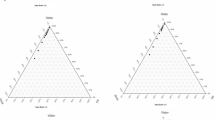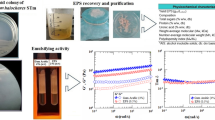Abstract
Exopolysaccharides (EPS) produced by bacteria are high molecular weight secondary metabolites having wide applications in food and pharmaceutical industry. In the present study, an exopolysaccharide producing bacterium was isolated from the root nodules of a leguminous plant and was studied for emulsification activity and biocompatibility using human dermal fibroblasts. Under optimum culture conditions, the purified EPS yield in modified YEM media was 2.8 g L−1 and was identified as β-glucan with the molecular weight 15.57 × 106 Da. The EPS showed high emulsifying activity against hydrocarbons such as petrol, kerosene, xylene, palm oil, coconut oil, and olive oil with emulsification index > 60% at 0.25 and 0.5% concentrations at 25 °C. The EPS was sensitive to high temperature, but the emulsions were stable at pH range 2–9 and in the salinity range of 1–20%. In vitro cell viability studies indicated that EPS was not cytotoxic at tested concentrations on human dermal fibroblasts moreover, it had proliferative activities. Hence, the EPS from Cronobacter sp. can be a good candidate for biotechnological application as a source of β-glucan with emulsifying and tissue regenerative properties.




Similar content being viewed by others

References
Poli A, Di Donato P, Abbamondi GR, Nicolaus B (2011) Synthesis, production, and biotechnological applications of exopolysaccharides and polyhydroxyalkanoates by archaea. Archaea 10:e693253
Suresh Kumar A, Mody K, Jha B (2007) Bacterial exopolysaccharides—a perception. J Basic Microbiol 47(2):103–117
Banat IM, Makkar RS, Cameotra SS (2000) Potential commercial applications of microbial surfactants. Appl Microbiol Biotechnol 53(5):495–508
De Almeida DG, Soares Da Silva RD, Luna JM, Rufino RD, Santos VA, Banat IM, Sarubbo LA (2016) Biosurfactants: promising molecules for petroleum biotechnology advances. Front Microbiol 7:e1718
Lopes EM, Castellane TC, Moretto C, Lemos EG, Souza JA (2014) Emulsification properties of bioemulsifiers produced by wild-type and mutant Bradyrhizobium elkanii strains. J Bioremediat Biodegrad 20(5):1–6
Priji P, Sajith S, Unni KN, Anderson RC, Benjamin S (2016) Pseudomonas sp. BUP6, a novel isolate from Malabari goat produces an efficient rhamnolipid type biosurfactant. J Basic Microbiol 57(1):21–33
Kaur V, Bera MB, Panesar BS, Chopra HK (2013) Production and characterization of exopolysaccharide produced by Alcaligenes faecalis B14 isolated from indigenous soil. Int J Biotechnol Bioeng Res 4:365–374
Huang KH, Chen BY, Shen FT, Young CC (2012) Optimization of exopolysaccharide production and diesel oil emulsifying properties in root nodulating bacteria. World J Microbiol Biotechnol 28(4):1367–1373
Sonawdekar S, Gupte A (2016) Production and characterization of exopolysaccharide produced by oil emulsifying bacteria. Int J Curr Microbiol App Sci 5(2):254–262
Gutierrez T, Berry D, Yang T, Mishamandani S, McKay L, Teske A, Aitken MD (2013) Role of bacterial exopolysaccharides in the fate of the oil released during the Deepwater Horizon oil spill. PLoS ONE 8(6):e67717
Malafaya PB, Silva GA, Reis RL (2007) Natural–origin polymers as carriers and scaffolds for biomolecules and cell delivery in tissue engineering applications. Adv Drug Deliv Rev 59(4):207–233
Lemechko P, Ramier J, Versace DL, Guezennec J, Simon-Colin C, Albanese P, Renard E, Langlois V (2013) Designing exopolysaccharide-graft-poly (3-hydroxyalkanoate) copolymers for electrospun scaffolds. React Funct Polym 73(1):237–243
Venkatesan J, Kim SK (2010) Chitosan composites for bone tissue engineering—an overview. Marine drugs 8(8):2252–2266
Senni K, Gueniche F, Yousfi M, Fioretti F, Godeau GJ, Colliec-Jouault S et al (2013) Sulfated depolymerized derivatives of expolysaccharides (EPS) from mesophilic marine bacteria, method for preparing the same, and uses thereof in tissue regeneration. United States patent US 8,598,142
Young CC, Arun AB, Lai WA, Chen WM, Chou JH, Shen FT, Rekha PD, Kämpfer P (2008) Chromobacterium aquaticum sp.nov., isolated from spring water samples. Int J Syst Evol Microbiol 58(4):877–880
Quesada E, Moral A, Béjar V (1994) Comparative methods for isolation of Volcaniella eurihalina exopolysaccharide. Biotechnol Tech 8:701–706
Nakanishi I, Kimura K, Suzuki T, Ishikawa M, Banno I, Sakane T et al (1976) Demonstration of curdlan-type polysaccharide and some other β-1, 3-glucan in microorganisms with aniline blue. J Gen Appl Microbiol 22(1):1–1
Dubois M, Gilles KA, Hamilton JK, Rebers PA, Smith F (1956) Colorimetric method for determination of sugars and related substances. Anal Chem 28(3):350–356
Lowry OH, Rosebrough NJ, Farr AL, Randall RJ (1951) Protein measurement with the Folin phenol reagent. J Biol Chem 193(1):265–275
Lee JS, Lee SU, Che CY, Lee JE (2015) Comparison of cytotoxicity and wound healing effect of carboxymethylcellulose and hyaluronic acid on human corneal epithelial cells. Int J Ophthalmol 8(2):215–221
Chase HR, Gopinath GR, Eshwar AK, Stoller A, Fricker-Feer C, Gangiredla J et al (2017) Comparative genomic characterization of the highly persistent and potentially virulent Cronobacter sakazakii ST83, CC65 Strain H322 and other ST83 strains. Front Microbiol 26(8):1136
Jung JH, Choi NY, Lee SY (2013) Biofilm formation and exopolysaccharide production by Cronobacter sakazakii depending on environmental conditions. Food Microbiol 34(1):70–80
Joseph S, Cetinkaya E, Drahovska H, Levican A, Figueras MJ, Forsythe SJ (2012) Cronobacter condimenti sp. nov., isolated from spiced meat, and Cronobacter universalis sp. nov., a species designation for Cronobacter sp. genomospecies, recovered from a leg infection, water and food ingredients. Int J Syst Evol Microbiol 62(6):1277–1283
Zhu F, Du B, Xu B (2016) A critical review on production and industrial applications of beta-glucans. Food Hydrocoll 52:275–288
Laroche C, Michaud P (2007) New developments and prospective applications for β (1, 3) glucans. Recent Pat Biotechnol 1(1):59–73
Ruffing AM, Chen RR (2012) Transcriptome profiling of a curdlan-producing Agrobacterium reveals conserved regulatory mechanisms of exopolysaccharide biosynthesis. Microb Cell Fact 11(1):17
Nishinari K, Zhang H, Ikeda S (2001) Hydrocolloid gels of polysaccharides and proteins. Curr Opin Colloid Interface Sci 3:195–201
Wang Q, Sheng X, Shi A, Hu H, Yang Y, Liu L (2017) β-glucans: relationships between modification, conformation and functional activities. Molecules 22(2):eE257
Woo YI, Park BJ, Kim HL, Lee MH, Kim J, Yang YI (2010) The biological activities of (1, 3)-(1, 6)-β-D-glucan and porous electrospun PLGA membranes containing β-glucan in human dermal fibroblasts and adipose tissue-derived stem cells. Biomed Mater 5(4):044109
Priyanka P, Arun AB, Young CC, Rekha PD (2015) Prospecting exopolysaccharides produced by selected bacteria associated with marine organisms for biotechnological applications. Chin J Polym Sci 2:236–244
Wei D, Zhang L, Williams DL, Browder IW (2002) Glucan stimulates human dermal fibroblast collagen biosynthesis through a nuclear factor-1 dependent mechanism. Wound Repair Regen 10(3):161–168
Sun ML, Zhao F, Shi M, Zhang XY, Zhou BC, Zhang YZ et al (2015) Characterization and biotechnological potential analysis of a new exopolysaccharide from the Arctic marine bacterium Polaribacter sp. SM1127. Sci Rep 21(5):e18435
Alcantara OL, Domenech NA, Astals AS, Montiel AF, Sanz NG (2017) Cosmetic composition containing halomonas ferment extract, and use thereof. United States patent application US 15/521,774
Cambon-Bonavita MA, Raguenes G, Jean J, Vincent P, Guezennec J (2002) A novel polymer produced by a bacterium isolated from a deep-sea hydrothermal vent polychaete annelid. J Appl Microbiol 93(2):310–315
Meneses C, Gonçalves T, Alquéres S, Rouws L, Serrato R, Vidal M, Baldani JI (2017) Gluconacetobacter diazotrophicus exopolysaccharide protects bacterial cells against oxidative stress in vitro and during rice plant colonization. Plant Soil 416(1):133–147
Meneses C, Rouws L, Araújo J, Vidal MS, Baldani JI (2011) Exopolysaccharide production is required for biofilm formation and plant colonization by the nitrogen-fixing endophyte Gluconacetobacter diazotrophicus. Mol Plant Microbe Interact 24(12):1448–1458
Acknowledgements
The authors acknowledge Prof CC Young, Chung-Hsing University, Taiwan for 16S rRNA gene sequencing. Fathimath Sadiya MK acknowledges Yenepoya University for the research fellowship and Sahana TG acknowledges DST INSPIRE fellowship.
Author information
Authors and Affiliations
Corresponding author
Ethics declarations
Conflict of interest
All authors have declared that they have no conflict of interest.
Electronic supplementary material
Below is the link to the electronic supplementary material.
Rights and permissions
About this article
Cite this article
Sahana, T.G., Fathimath Sadiya, M.K. & Rekha, P.D. Emulsifying and Cell Proliferative Abilities of the Exopolysaccharide Produced by Leguminous Plant Nodule Associated Bacterium Cronobacter sp.. J Polym Environ 26, 3382–3388 (2018). https://doi.org/10.1007/s10924-018-1223-6
Published:
Issue Date:
DOI: https://doi.org/10.1007/s10924-018-1223-6



